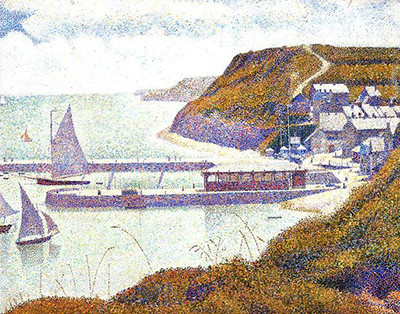Harbour at Port-en-Bessin, executed in 1888, is an oil-on-canvas painting by Georges Seurat of a small fishing town on the Normandy coast. The landscape painting, created in the open air during the summer months when the French artist liked to leave his studio and paint outdoors, features two jetties that project from the beach on the right-hand side of the canvas into the rising sea that dominates the left-hand side of the painting. Three sailing vessels, which one can assume are part of the fishing fleet, congregate around the jetties while other craft are visible in the distance. The village itself, surrounded by cliffs, is situated behind the beach while the tops of the cliffs are covered in grass.
Seurat, who created several landscape paintings during his summer expeditions to the French coast, painted the harbour from an elevated position where the village and jetties could be seen below. The French artist, sitting near the edge of the cliff-top, liked to escape the confines of his studio during the summer and paint in the natural light. Émile Verhaeren, a friend of the painter, claimed that the artist likened his trips to the coast as a cleansing process in which he would wash the artificial light of the studio from his eyes. The landscape, seen from an eastern perspective, is illuminated by the intense rays of the summer sun.
The largest of the three vessels that surround the jetties, of which the port-side is visible, is situated between the two structures and has a single mast onto which a high-peaked quadrilateral sail is fixed between a boom and a spar. The boat, its bow pointing left, appears to be leaving the harbour. Gaff-rigged vessels, on which a four-sided sail joins the mast along the line of the keel, were common in French ports during the late-nineteenth century and were used on fishing craft as well as merchant vessels. A wooden building, situated on the jetty that is closest to the viewer, has been erected near to the point where the jetty meets the beach.
The two smaller boats, one of which possesses a transom stern, are equipped with a lug-sail on the mainmast while the foremost boat possesses a triangular foresail. Luggers, equipped with one or more lug-sails, were often used as fishing vessels along the Normandy coast. The triangular foresail is attached to the forestay that runs between the mainmast and the stem-post or, as in the case of the boat that is closest to the viewer, the tip of the bowsprit.




